Your conveyors will have extended lifetime, if simple procedures, routine checkups, and maintenance are applied. The following document demonstrates some of the most common conveyor challenges that are easy to spot with basic visual inspection and their solutions in a short amount of time.
Well-constructed conveyor designs and clean maintenance are crucial for safe and productive material handling system. Below are potential causes and preventative solutions for the most commonly encountered belt problems.
Problem: Belt getting off-track when it comes to certain place
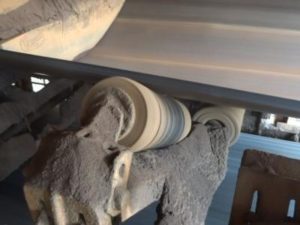 Cause: Buildup of Material on Idler/Pulley
Cause: Buildup of Material on Idler/Pulley
Solution:
- Install Scraper, or any other cleaning devices. If already installed check the cleanliness and properly treat/replace as needed
- Remove any material build up on that point and clean up any spills along the system
Cause: Belt rotated towards sticky idler at certain point
Solution:
- Install non-grip rollers with molded disc rolls
- Put lubricant on the rolls
Cause: Misaligned (non-centered) idlers or out-of-square Pulleys
- Readjust the position of the relevant conveyor component for straight tracking
Cause: Idler at the point of distortion does not rotate well
- All idlers need to be periodically adjusted and cleaned.
- If the lack of rotation continues after cleaning, replace the idler.
- Tighten it, if it went loose
Cause: Conveyor frame is distorted at a certain point.
- Check the distorted point; stretch the thread in order to improve the horizontality and verticality.
Problem: Portion of belt runs to one side all along the line
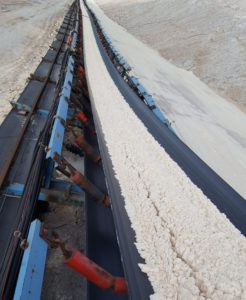 Cause: Improper splicing.
Cause: Improper splicing.
- Take out the belt and re-splice it.
Cause: Belt has been recently installed, troughability has not taken its shape yet.
- After a couple of days, the belt will straighten out under full load. If not, that means ideal storage conditions are not met. Special assistance on the storage conditions should be shared.
Problem: Entire belt makes crooked running along the complete belt line
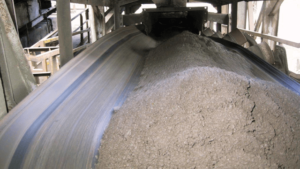 Cause: Transported materials are leaned towards one side. This mostly happens when the particle size varies.
Cause: Transported materials are leaned towards one side. This mostly happens when the particle size varies.
- Arrange the fall from the chute to be balanced between fine and larger pieces.
Cause: The belt loses its centralization at the pulley and at the loading area.
- Install training idlers before the tail pulley on the return side.
Cause: Overload of material and poor loading
- Make sure the material falling speed does not exceed the belt speed and ensure
the material falls at the center of the belt line.
Cause: Overload on one side of idlers
- Clean the idler, installation of scrapers will help dramatically.
The frame is distorted.
- Change the idler after correcting the frame.
Cause: Misaligned (non-centered) idlers or out-of-square Pulleys
- Measure horizontality and perpendicularity all idlers and correct the abnormality.
Cause: Wind or rain
- Install a windbreak or use a better cover
Cause: Sunshine, one side being exposed to sunlight more than the other
- Apply coating to protect the cover
Problem: Premature Top Cover Abrasion
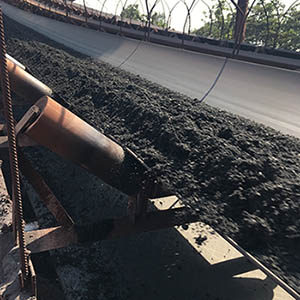
Cause: The falling speed at the chute exceeds the allowed belt speed.
- Lower the speed of the load accordingly.
Cause: Material overload at the chute
- Install impact idlers
- Minimize the chute angle and improve chute design for smooth feeding
- Use a movable bar at the chute
Cause: Excessive sag
- Narrow down the spacing between idlers
- Increase the belt tension
- Increase the weight of transported material
Cause: Cover quality not sufficient to bear the abrasion level
- Replace the belt with cover with less abrasion loss
Cause: Off-center loading
- Ensure that the materials drop onto the center of the belt
- Make sure the falling speed does not exceed the belt speed
Cause: Material build-up on return idlers
- Use cleaning devices, like scrapers
- Use disc type return idlers
Problem: Belt Slippage Around the Pulley
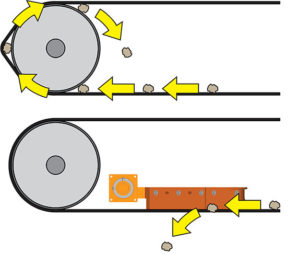 Cause: Small pulleys, incorrect/abraded lagging
Cause: Small pulleys, incorrect/abraded lagging
- Make sure the pulley size meets the minimum requirement, according to the tensile strength and number of plies.
- Replace the rubber lagging, if overly used
- Use ceramic lagging, with a higher coefficient of friction
Problem: Excessive Elongation of Belt
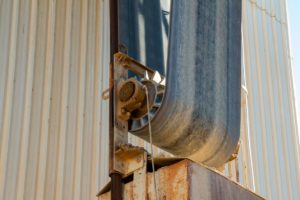 Cause: Tension is too high
Cause: Tension is too high
- Reduce the counterweight
- Reduce the weight of the material
Cause: Wrong choice of belts: Belt tensile strength not withstanding the system requirement
- Replace the line with a higher tensile strength belt, if the pulley diameter and motor power is suitable for it
Cause: Misapplication of the splicing
- Make sure the splicing is done by professionals, consult the closest Derby team
Problem: Hard or cracking Cover
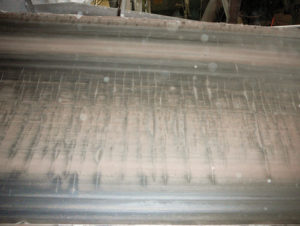 Cause: Wrong choice of belts
Cause: Wrong choice of belts
- Use heat resistant belts
Cause: Too much use
- Replace the belt
Problem: Abnormal Injury at the Belt Edge
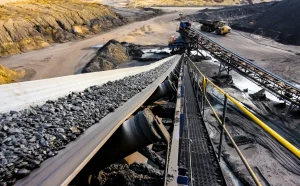 Cause: Crooked/Off-center Running
Cause: Crooked/Off-center Running
- Expand the allowance of the conveyor frame
- If tripper is used


